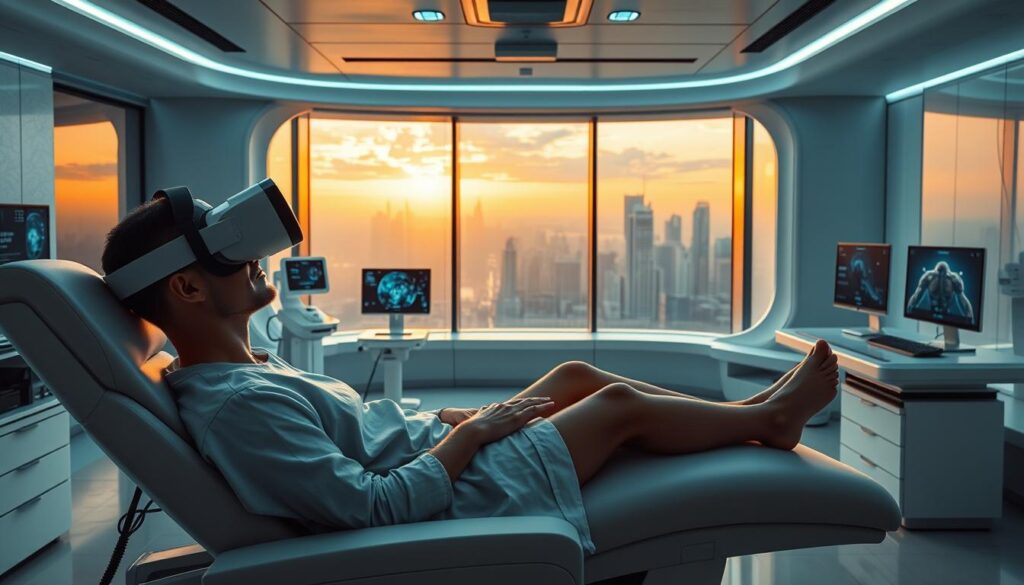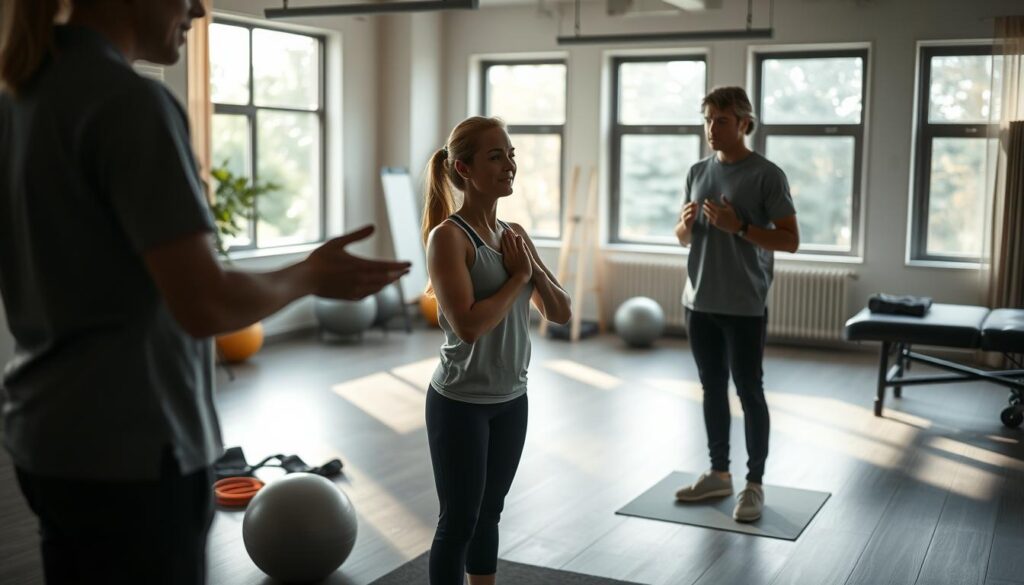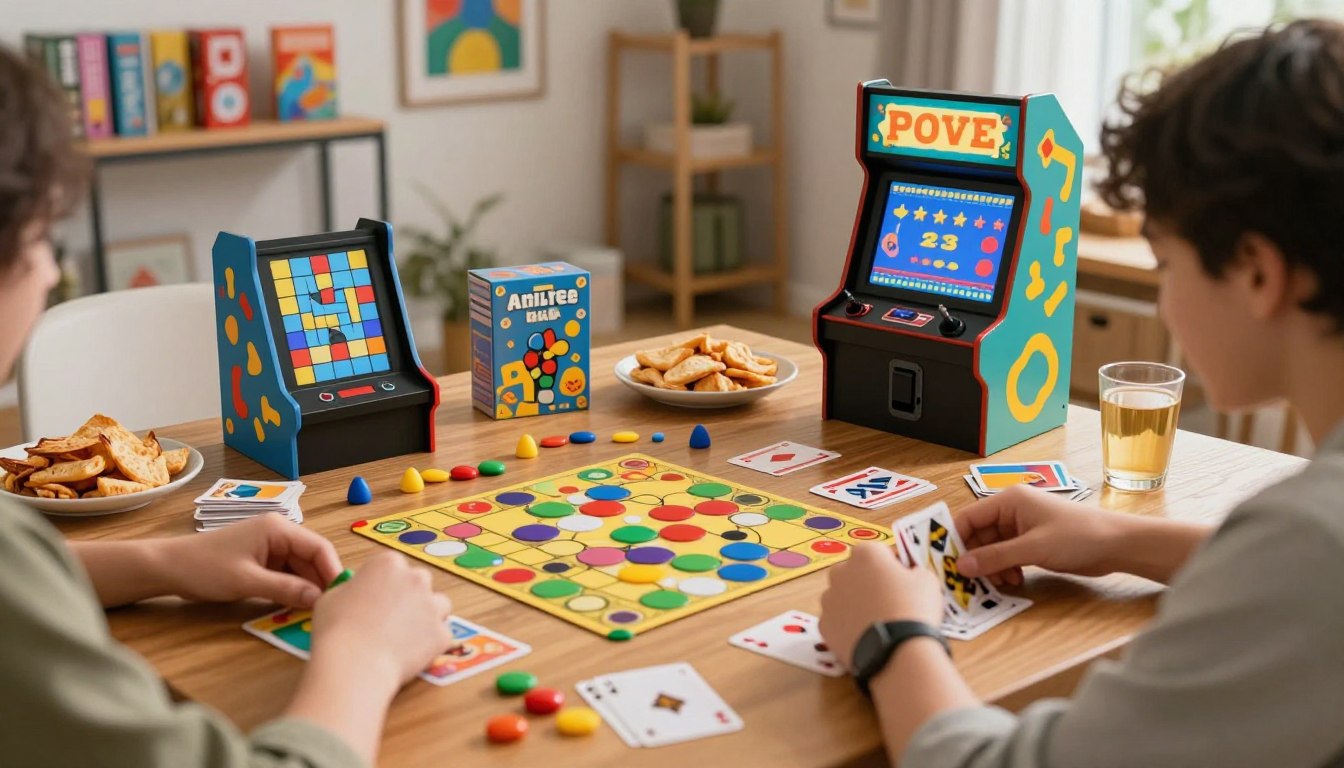Anúncios
Can virtual reality change how we do breathing exercises in physical therapy? Virtual reality games for breathing are a new way to help people get better. They make exercises fun and help patients in a way old methods can’t.
VR therapy lets people play in virtual worlds. This makes breathing exercises more fun. It also helps patients in a way that feels more complete.
Anúncios
Let’s see how these new tools can make rehab better. They can make patients more involved in their care.
The Rise of Virtual Reality in Healthcare
Virtual reality in healthcare has made big changes in medical practices. More doctors are seeing the value of VR in medicine. It helps with pain management and training, making care better for patients.
Studies show VR tools help patients get more involved in their care. They can explore safe spaces that help with therapy. This is a big change from old ways of treating patients.
Anúncios
Doctors are using VR for training too. It lets them practice without risking patients. This way, they learn a lot and get better at their jobs.
| VR Applications in Medicine | Benefits | Real-World Examples |
|---|---|---|
| Pain Management | Reduces pain perception and anxiety | Burn units using VR to distract patients during dressing changes |
| Surgical Training | Provides risk-free practice opportunities | Simulators for complex surgical procedures |
| Rehabilitation | Increases patient motivation | VR exercises tailored for physical therapy |
| Mental Health Treatment | Offers exposure therapy in a safe environment | VR for treating PTSD and phobias |

Understanding Breathing Exercises in Physical Therapy
Breathing exercises are key in physical therapy. They help patients strengthen their breathing muscles and increase lung capacity. Diaphragmatic breathing is a mainstay in rehab programs. It leads to deeper breathing and better oxygen intake, helping with respiratory recovery.
Pursed lip breathing is another common method. It helps control breathing by making exhalation longer. This reduces shortness of breath and boosts ventilation. Both methods can be adjusted for each patient, making rehab more personal.
Structured breathing exercises are part of a bigger rehab plan. It’s important for patients to stick with it and stay motivated. Therapists use different exercises to keep patients interested and show how important these techniques are.

| Breathing Exercise | Description | Benefits |
|---|---|---|
| Diaphragmatic Breathing | Focuses on using the diaphragm for deep breathing | Increases lung capacity and oxygen intake |
| Pursed Lip Breathing | Controls breathing by prolonging exhalation | Improves ventilation and reduces shortness of breath |
| Inspiratory Muscle Training | Strengthens respiratory muscles through resistance exercises | Enhances overall breathing efficiency |
| Segmental Breathing | Encourages expansion of different lung regions | Promotes lung re-expansion in patients with atelectasis |
Importance of Breathing Exercises for Rehabilitation
Breathing exercises are key for those recovering from lung problems. They help improve pulmonary health a lot. This is especially true for people with COPD or asthma.
Adding respiratory exercises to therapy can really boost lung function. These exercises help the lungs work better.
Practicing breathing techniques helps get more oxygen to the body. This is vital for healing. It also helps control symptoms like shortness of breath.
With better breathing, patients can do more physical activities. This makes daily life easier and improves their overall well-being.
Respiratory exercises also boost physical endurance. This means people can do more things every day. They feel more confident and empowered, showing how important these exercises are.
How VR Games Enhance Engagement in Therapy
VR games in therapy change how we do rehabilitation. They mix fun into the usual treatment plans. This makes recovery exciting and interactive, which helps patients stay involved.
These games let patients do breathing exercises in cool places. This helps them forget the pain of physical therapy.
VR games make therapy more fun and rewarding. Patients get to interact with their environment and feel good about their progress. This makes them more likely to stick to their treatment plans.
VR therapy makes each session a fun experience, not just a task. The stories and challenges keep patients motivated to recover. This leads to better results over time.
So, VR and therapy together show the future of patient care. They help overcome physical and mental challenges during recovery.
Virtual Reality Respiratory Training Games for Physiotherapy
Virtual reality (VR) games change physiotherapy by making breathing exercises fun. They offer interactive therapy that grabs attention and boosts rehab success. VR platforms are now made to teach specific breathing skills, making training personal and dynamic.
Overview of VR Games in Physical Therapy
VR games use advanced tech for immersive experiences that improve breathing. Platforms like Oculus and HTC Vive have apps for different abilities and goals. These games make breathing exercises fun by adding challenges and virtual interactions.
Mechanisms of Action in VR Breathing Exercises
VR in respiratory training works in several ways. It uses biofeedback to show breath patterns in real time. It also adjusts game difficulty based on how well you do, making it more effective.
This feedback loop helps patients focus on their breathing. It also makes therapy more enjoyable and effective.
Immersive Environments and Their Benefits
Immersive environments are key in making calming settings for breathing exercises in physical therapy. They use peaceful virtual landscapes for relaxation and focus. This helps patients get away from the stress of hospital or clinic settings.
Creating Calm and Focused Settings
The surroundings matter a lot when doing breathing exercises. Immersive VR creates calm and engaging places for patients to relax. It makes therapy more effective by reducing stress and improving focus.
Reduction of Anxiety and Stress Through VR
VR is not just fun; it also helps lower anxiety and stress. People using VR in therapy feel calmer and safer. This lets them focus better on their breathing without outside distractions.
Patient Adherence and Motivation Factors
Success in rehabilitation depends a lot on patient motivation and sticking to therapy. Traditional methods can be boring, leading to less commitment. But, VR for rehabilitation is changing this. It makes exercises fun and exciting, keeping patients interested and involved.
VR offers rewards and milestones, which motivates patients to keep going. It creates immersive environments that make therapy sessions enjoyable. This approach makes patients feel like they’re making progress, boosting their motivation.
VR uses new ways to keep patients engaged in therapy. It helps patients feel connected to their recovery. In short, VR in physical therapy is a big step forward. It opens new ways to motivate and keep patients on track.
Combining Biofeedback with VR Breathing Exercises
Using biofeedback in therapy with VR systems is a new way to improve breathing exercises. It lets users see how they breathe while in a virtual world. Different biofeedback methods help show and improve breathing techniques.
Types of Biofeedback in VR Systems
VR systems use many biofeedback types to help with breathing. Visual feedback shows breath patterns as graphics, helping users see their impact. Auditory prompts tell when to breathe, making sure techniques are right.
These tools work together to monitor and improve breathing. They make learning to breathe better in a virtual world.
Improving Breathing Technique with Real-Time Feedback
Real-time feedback is key to learning to breathe well. Users get instant feedback on their breathing. This helps them adjust and understand their breathing better.
Getting feedback right away helps users practice correctly. This makes learning and improving breathing easier and more effective.
Research Findings on VR and Pulmonary Rehabilitation
Recent studies on VR in therapy show great promise for pulmonary rehabilitation. Many studies point to VR’s effectiveness in improving lung training for those with lung issues. They found that VR can make sticking to exercise plans easier.
Patients who used VR therapy were happier than those who didn’t. This shows VR’s potential in making therapy more enjoyable.
VR has also been shown to improve lung function and exercise ability in studies. These findings suggest VR’s immersive quality can help in both physical and mental healing. As more research is done, using VR in rehab programs looks more promising.
Challenges in Implementing VR in Therapy
Using virtual reality (VR) in therapy comes with many challenges. One big issue is the high cost of VR equipment. This can stop many places from using it. Also, keeping the software up to date adds to the expenses.
There are technical hurdles too. VR might not work well with current healthcare systems. It also needs strong internet to function. These problems can make it hard for doctors to use VR to help patients.
Another problem is training doctors to use VR. Many healthcare workers might not know how to use VR systems. They might not be excited about trying something new.
To make VR work in therapy, we need to solve these problems. We must focus on training, cost, and technical help. This will help create a team that can use VR to improve patient care.
Future Directions for VR in Physical Therapy
The future of VR therapy in physical rehabilitation looks bright. New technologies are coming that will make therapy better. For example, haptic feedback lets users feel real sensations, making exercises more realistic.
This can help patients learn and remember exercises better. AI systems are also being developed. They can make VR experiences fit each patient’s needs.
These systems will watch how patients do and change the virtual world to help them. This means therapy can be more effective. Research is also working on making VR therapy easier for everyone to use.
As VR therapy becomes more common, it will change how we do physical therapy. It will help people in different ways, solving problems for many patients.
The Role of Clinicians in VR Therapy Sessions
Virtual reality (VR) is changing therapy sessions in big ways. Clinicians in VR are key to making therapy safe and effective. They must know how to use VR tech while keeping an eye on the patient’s comfort and needs.
Clinicians guide patients through VR, tailoring experiences to fit each person’s needs. This makes therapy more engaging and helpful. They also watch how patients react, making sure they’re comfortable and handling any problems fast.
Having a clinician present is crucial for VR therapy to work best. They teach patients about VR, helping to reduce fears and boost motivation. This support is vital for better patient results, showing how important clinicians are in VR therapy.
| Clinician Role | Responsibilities |
|---|---|
| Technology Facilitator | Ensure appropriate use of VR tools during therapy sessions. |
| Personalization Expert | Customize VR experiences based on individual patient needs and progress. |
| Safety Monitor | Observe patient reactions and address any discomfort or issues promptly. |
| Patient Educator | Explain VR technology to patients, alleviating concerns and enhancing motivation. |
Patient Testimonials and Success Stories
Virtual reality in physical therapy has gotten lots of good feedback from patients. People say VR therapy has changed how they see rehab. They find it easier to do breathing exercises because of the immersive VR worlds.
Many patients have seen big changes in their physical skills. They say they can breathe better and feel more confident after using VR. These stories are not just about progress; they inspire others who are going through tough times.
A recent survey showed how VR therapy has helped patients. They feel more motivated and less anxious because VR makes therapy fun and interactive. This shows how technology can really help in healing, especially for those who didn’t do well with old methods.
| Patient Experience | Improvement Noted |
|---|---|
| Samantha A. | Increased breathing control and reduced stress levels |
| Mark J. | Enhanced lung capacity during physical activities |
| Lisa R. | Greater motivation to complete exercises consistently |
| Tom S. | Improved relaxation techniques and coping mechanisms |
These stories show the real benefits of VR therapy. They prove that VR can make a big difference in recovery. As more people try VR therapy, the number of success stories keeps growing. This gives hope to those facing challenges in their healing journey.
Integrating VR into Traditional Treatment Practices
Adding VR to traditional treatments can really help patients. This mix uses the best of both worlds. It makes therapy more engaging and effective for everyone.
Developing care plans that include both in-person and VR therapy is key. This way, patients get the comfort of traditional therapy and the benefits of VR. It shows how combining therapies can meet different patient needs.
Doctors can use VR to make treatments more flexible and appealing. This approach can change how we do rehabilitation, making it more innovative. It helps create a supportive space where patients feel empowered to recover.
Current Trends in VR and Healthcare Technology
VR technology is changing how we care for patients. It’s being used more in therapy and training. This new way of using VR makes rehab better for patients.
Telehealth is also growing fast. Doctors are using online platforms to see patients from anywhere. This helps keep care going, even when we can’t meet in person.
Machine learning is another big trend. It helps doctors make better diagnoses and treatments. It also helps predict health problems before they start. Using VR with these technologies makes care more complete and personal.
Conclusion
VR in physical therapy is a big step forward. It makes breathing exercises more effective. The data and stories show VR boosts patient engagement and motivation.
VR makes therapy fun and effective. It creates a controlled, interactive space for patients. This leads to better results in rehabilitation.
Research shows VR’s big role in future rehab. It’s key for improving patient well-being. Healthcare needs to focus on developing VR methods.
VR games in therapy are promising. They can lead to better patient outcomes. Healthcare professionals should use these innovations for the best care.
FAQ
How does virtual reality enhance breathing exercises in physical therapy?
Virtual reality makes breathing exercises more fun and engaging. It turns simple exercises into games. This makes therapy more enjoyable and helps patients stick to it.
What types of breathing exercises are commonly used in physical therapy?
Physical therapy often uses diaphragmatic and pursed lip breathing. These exercises help strengthen the lungs and aid in recovery from breathing problems.
What role do breathing exercises play in the rehabilitation of respiratory conditions?
Breathing exercises are key for patients with COPD, asthma, and after surgery. They boost lung function and physical strength, improving life quality.
How does virtual reality overcome challenges in patient engagement during therapy?
Virtual reality makes therapy fun by adding games and rewards. It makes sessions more enjoyable and helps patients stay motivated.
What types of biofeedback are integrated into VR systems for breathing exercises?
VR systems use visual and sound biofeedback to help adjust breathing. This feedback helps patients learn and understand their breathing better.
What evidence supports the effectiveness of VR in pulmonary rehabilitation?
Studies show VR improves lung function and rehabilitation results. It can even be better than traditional methods, making patients happier and more engaged.
What challenges exist when implementing VR technology in physical therapy?
Using VR in therapy faces challenges like high costs and technical issues. Clinicians also need training, and some may be hesitant to use it.
How do clinicians enhance VR therapy sessions?
Clinicians make VR therapy better by customizing it for each patient. They ensure safety and teach how to use VR tools effectively.
What emerging trends in VR and healthcare technology are expected in the future?
Future VR in healthcare might include better haptic feedback and AI customization. It will also reach more patients, thanks to ongoing research.
How can VR be integrated into traditional treatment practices?
VR can be added to traditional therapy by combining it with in-person sessions. This approach offers more support and flexibility in patient care.




